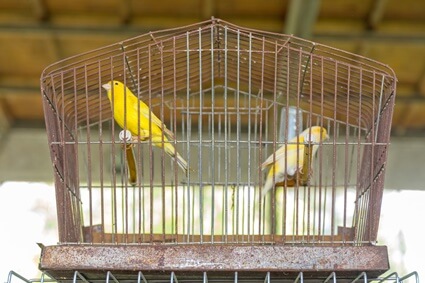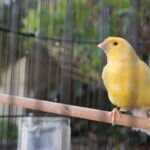Happy canaries are extremely vocal and will sing, whistle, chirp, and chatter.
They’ll remain active by grooming themselves, flying within their cage, flapping their wings, and wagging their tails. Their eyes will dilate when given attention, and some will hang upside down from their cages.
These signs show that your canary is contented with its life and in a good mood. If your canary is unhappy, there are many things you can do to enrich its life.
This can include changes to its cage, diet, toys, handling, and more comprehensive solutions, like providing a new routine and separating it from stress-inducing pets.
How To Tell If A Canary Is Happy?
Canaries experience emotions, including happiness, sadness, excitement, and curiosity.
Canaries have different vocalizations and body language than humans, but they can express their feelings clearly. The most obvious emotion canaries show is happiness, as they’re eager to make noise and become active when healthy and in a good mood.
In particular, you’ll know your canary is joyful when it expresses it as:
1/ Singing
Canaries are good singers, producing more melodic songs than most other birds.
According to Behavioral and Neural Biology, canaries add and remove syllables in their melodies as they age and grow. Canaries use these vocalizations to communicate with other birds and share their feelings.
Females often choose males based on their singing abilities because louder and more complex songs indicate the male has vitality and strong genes.
So, a canary that sings for long periods is healthy, energetic, and happy. Canaries vocalize less often and with less intensity when sad. If your canary is loud, it’s in a good mood.
Some female canaries can sing, but their melodies are quieter and less skillful. So, singing is a positive sign from a female canary, but don’t expect males and females to have the same ability level.

2/ Whistling And Chirping
A canary often whistles or chirps for fun when talking to a cage mate or entertaining itself with noise.
That’s especially true for females. Since they lack strong singing abilities, females are more prone to chirping to communicate or draw attention.
Chirps are easily identified as quick, soft noises, while whistling is often one sustained note. You may find your canary greets you upon entering the room with a quick chirp or starts its morning with long whistles.
3/ Chattering
Chattering sounds like a solitary note that’s repeated quickly and consistently. It’s similar to warbling but without the variety or sense of melody.
When a canary chatters, it’s warming up its voice for other vocalizations. In young canaries, it means they’re practicing with their voice box to eventually learn how to sing.
Canaries only chatter when comfortable with their environment. If they’re upset or scared, they’ll avoid drawing attention to themselves by making noise. If your canary feels safe enough to test its voice and produce mellow sounds, it feels happy and secure.
4/ Preening
Canaries enjoy preening themselves and tidying up their feathers. The process requires them to dip their head down to reach their chest feathers or bite gently at their wings. It’s difficult to watch for predators and threats in this position or at any point when preening.
So, canaries only preen freely when they feel safe. Poor grooming indicates sadness in canaries whose feathers become uneven and frayed. If a canary cleans its feathers, it’s content in its environment.
According to the Annals of the New York Academy of Sciences, preening is a soothing behavior that relaxes canaries. So, you may find a happy canary tidying up its feathers and beginning to sing.
5/ Flying
With enough space in their cage, canaries will exercise and explore by hopping from one perch to another, flying to different levels in the cage, and playing with toys.
Canaries that feel scared or sad will often isolate themselves to one area. They’ll avoid moving (and drawing attention to themselves), ignore toys, or sit at the bottom of their cage.
If your canary is active and engaged in its cage, it’s happy with its space and joyful enough to have ample, healthy energy expressed through flying, hopping, and exploring.
6/ Flapping Wings
When canaries feel happy, they may flap their wings rapidly without quite taking off. This is a way for them to expel the pent-up energy they feel from being so excited.
In addition to sharing their feelings, it’s also a way for them to exercise their wings. They wouldn’t draw attention to themselves if they felt displeased or scared.
7/ Tail Wagging
If you sing to the canary, turn on its favorite classical music, or the bird is pleased about a bright new morning, it may wag its tail quickly and flap its wings alongside the gesture.
However, tail fanning is a sign of aggression, while a tail bobbing up and down means it’s having trouble breathing. So, it may be out of breath or showing signs of a respiratory illness.
8/ Hanging Upside Down
Although more common in budgies or cockatiels, your canary may enjoy hanging upside down. This is a way to entertain itself and usually means that your canary is acting silly.
Hanging upside down is a vulnerable position that makes it difficult for canaries to stay on guard. Your canary must feel entirely safe to engage in this behavior. As long as it’s not displaying any signs of illness or loss of coordination, it’s just a fun habit.
9/ Curiosity
A happy canary will be curious about new toys, foods, or perches in its cage. Adding perches at different heights, providing a hanging bell, or offering your canary a treat should be met with eager curiosity.
Unhappy canaries often ignore new things or react aggressively if you reach inside their cage. If your canary is happy, it’ll be excited to check out whatever new things you offer, as long as they don’t upset the familiar constants in its routine and cage.
10/ Friendly
Canaries aren’t social and don’t form as complex bonds as other, larger birds, so they can live alone. However, despite rarely getting lonely, canaries are friendly and even-tempered birds.
If you socialize with your canary regularly, it’ll come to know and respond to your presence. This may include singing back if you sing to it (especially with males), bouncing to the edge of its cage to greet you, or even perching on your finger.
Of course, some canaries are more social with their owners than others, but a responsive, friendly disposition often means happiness in canaries.
When sad or scared, they withdraw from their owners or ignore any attempts at socializing. If your canary is pleased to sing with you or responds when you interact, it feels safe, comfortable, and happy.
How To Make A Canary Happy?
It’s possible that your canary doesn’t react to the above signs of happiness, which is especially common if the canary is new to your household and still adjusting.
Likewise, if you have little experience caring for canaries, it may be difficult to create an environment that makes the canary happy. However, there are adjustments you can make to bring your canary joy:
Proper Handling
Canaries are shy birds that don’t require much socializing to be happy, so you must be careful during handling so you don’t overwhelm or upset them.
Gradually train your canary to get used to your hands by placing your hand near the canary without moving it. That way, it’ll realize that a hand doesn’t automatically mean getting handled. You can also offer treats by hand or gently train the canary to perch on your finger.
Right Cage
Canaries spend most of their time in cages. Happy canaries require an enclosure that’s spacious, correctly shaped, and full of enrichment. In particular, this means:
- For one canary, the minimum size is 18x18x18 inches.
- Increase the length for more canaries.
- Longer cages are better, as they allow space for flight.
- Don’t buy a round cage, as canaries feel safer in corners, and round cages cause stress.
- The bars should be no more than ½ inches apart.
- Include multiple wooden perches at differing levels so the canary can get a good grip.
- Add several toys to entertain the canary, such as bells, crinkle paper, hoops, ladders, and bridges.
Well Fed
A balanced diet will improve its mood, feather quality, energy levels, and resistance to disease, all of which affect its mental disposition. Keep these pointers in mind:
- Don’t feed your canary seeds alone, as they often lack key nutrients.
- Offer variety so your canary doesn’t become disinterested or bored with its meals.
- Treats including veggies, fruits, grains, and different kinds of seeds are good for their health.
- Remove food 30 minutes after your canary has finished eating to avoid bacteria.
- Provide a clean source of water that’s available at all times.

Comfortable Environment
Canaries are delicate birds, and stress is the main cause of illness and unhappiness.
Place your canary in a quiet room and away from heavy foot traffic. Provide natural lighting throughout the day, but avoid direct sunlight to prevent overheating. A UV lamp is ideal if sunlight is limited.
Canaries should be placed in a corner, against two walls. Placing the cage in an open space makes the canary feel vulnerable.
Likewise, avoid windows. Predators like birds or cats may be visible to your canary and stress it out.
No Other Animals
It’s best to place your canary in a room where other pets can’t access it. Even if they don’t harm the bird directly, loud barking, quick movements, or consistent staring is enough to scare a canary.
No Small Children
Small children mean well, but they tend to be loud, eager to touch and handle, and too active for a canary to relax around. Leaving small children unattended around a canary’s cage may also lead to a child poking at or bothering the canary, which can stress it.
Routine
Canaries thrive on routine, and significant changes to their lifestyle upset them.
Cover and uncover the cage at the same times each day so it has a normal day and night routine. Feed it on a schedule, and clean its enclosure regularly.
Your canary will learn your routine and may get upset if it is disrupted. For example, your canary may know when you leave for work or when you’re about to arrive home. So, providing it with structure will teach it what to expect and help it feel more at home.
If your canary is new, don’t expect it to be comfortable immediately. Sometimes, a canary that isn’t happy isn’t ill and is adjusting to a new home, routine, or cage.








